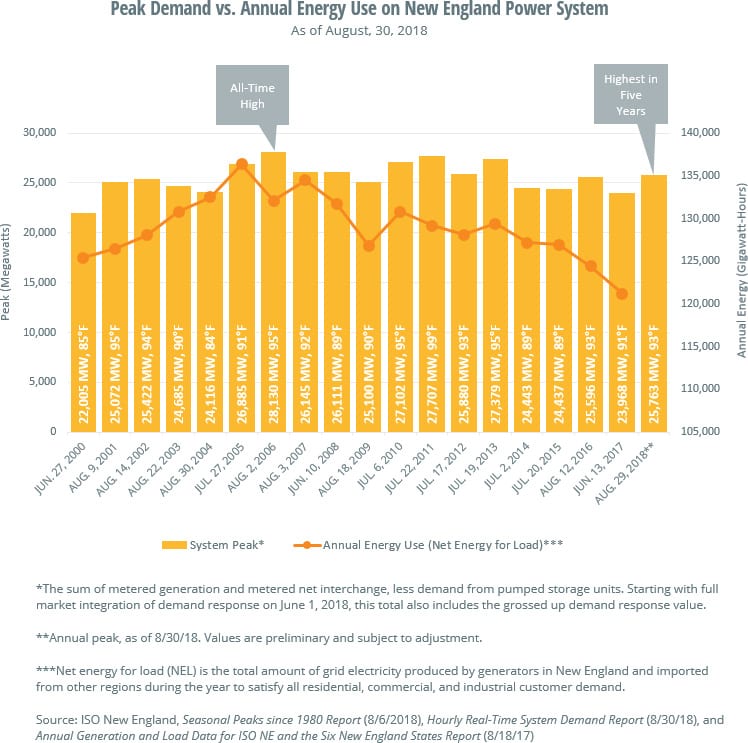Summer 2018: Air conditioners get a workout
 Operating the region’s power system changes with the seasons. New England is a summer-peaking system, but summer 2018 was marked by spells of hot and humid weather that drove consumer demand to peaks not seen in years and tested power system operations. Reliable grid operations were maintained throughout a summer that was bookended by holiday weather events: a heat wave in early July and an extremely hot and sticky Labor Day weekend.
Operating the region’s power system changes with the seasons. New England is a summer-peaking system, but summer 2018 was marked by spells of hot and humid weather that drove consumer demand to peaks not seen in years and tested power system operations. Reliable grid operations were maintained throughout a summer that was bookended by holiday weather events: a heat wave in early July and an extremely hot and sticky Labor Day weekend.
Humidity, heat waves, and high peaks
After a mild season in 2017, this past summer was considerably warmer and more humid. Average temperatures in New England were up 4 degrees in July and 5 degrees in August, when compared to 2017. The region saw a 72 percent increase in cooling degree days* over the course of the three summer months.
An early July heat wave, coinciding with the Independence Day holiday, pushed temperatures above 90 degrees for more than a week in some areas of New England and led to a spike in consumer demand as residents and businesses cranked up their air conditioning. Demand on Sunday, July 1, ranked among the top 10 highest weekend demand days the region has seen. Power system operations during the heat wave remained reliable.
More hot weather at the end of August led to the highest demand peak seen in New England since 2013, with temperatures hitting an average 93 degrees across the six-state region on August 29. The high demand served as a reminder that, even as total annual power usage is slowing, the ISO still must remain prepared for periods of high demand under certain conditions.
Overall, consumer demand for electricity was up 5.3 percent in 2018, compared to the previous summer.

Labor Day no holiday
Though the calendar had turned to September, the warm weather continued on Labor Day. Hotter-than-expected temperatures coupled with a high level of unexpected generation outages led to a shortage in power system operating reserves in New England. The reserve shortage led ISO operators to implement several steps of a well-established operating procedure for dealing with such situations, and marked the first scarcity event under the ISO’s new Pay-for-Performance rules, which took effect on June 1.
Price-responsive demand launches
This summer also marked the launch of the ISO’s price-responsive demand structure, a set of market rules, processes, and systems that allow active demand resources to participate in the full range of wholesale electricity markets in New England. During the first three months, active demand response accounted for 10.4 gigawatt-hours (GWh) of reduced system demand.
*A degree day is a measure of heating or cooling. A zero-degree day occurs when no heating or cooling is required; as temperatures drop, more heating days are recorded; when temperatures rise, more cooling days are recorded. The base point for measuring degree days is 65 degrees. Each degree of a day’s mean temperature that is above 65 degrees is counted as one cooling degree day, while each degree of a day’s mean temperature that is below 65 degrees is counted as one heating degree day. A day’s mean temperature of 90 degrees equals 25 cooling degree days, while a day’s mean temperature of 45 degrees equals 20 heating degree days.
- Categories
- Inside ISO New England
- Tags
- demand resources, peak demand, summer, system operations
